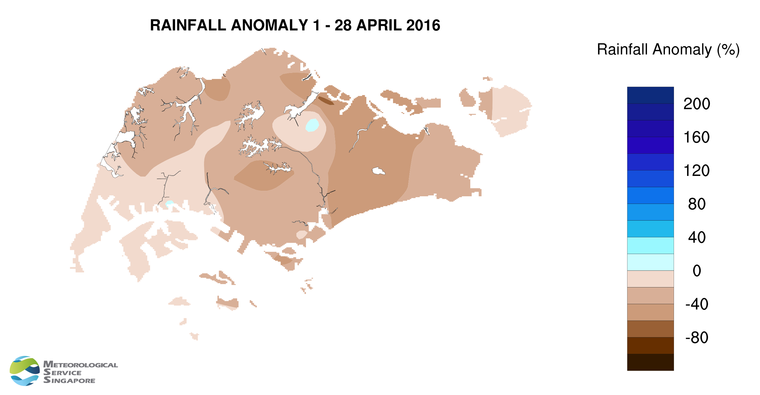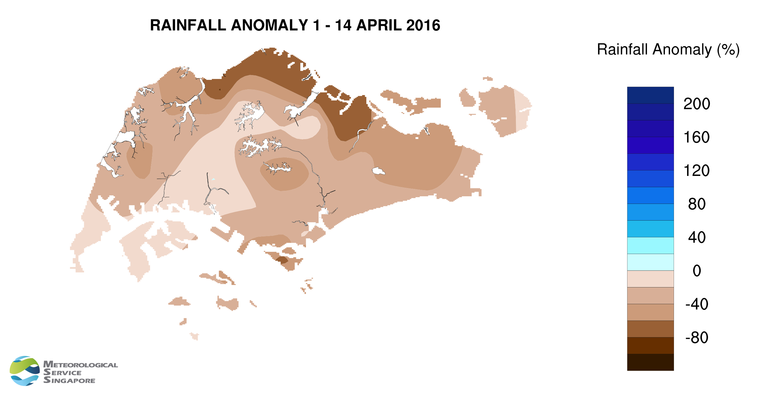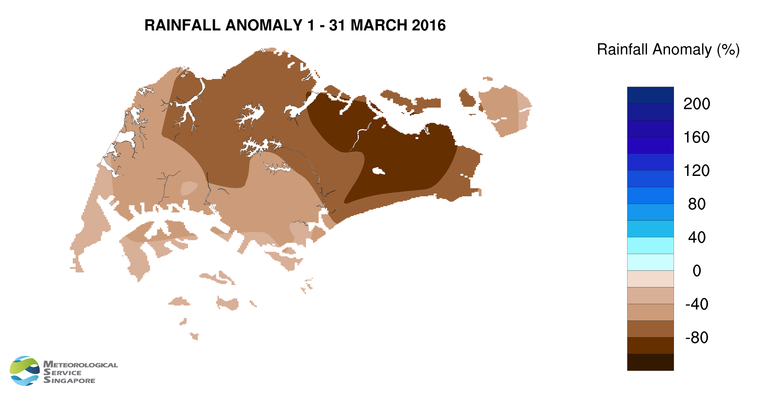Public can take measures to minimise risk of heat-induced illnesses during warm weather
Advisory
Singapore, 20 April 2016 – As forecast in Meteorological Service Singapore’s (MSS) fortnightly weather outlook issued on 15 April 2016, Singapore has been experiencing significantly warmer temperatures over many parts of the island in the past few days. On 17 and 18 April 2016, the daily maximum temperatures recorded at weather stations islandwide ranged between 31.4°C and 36.4°C and between 31.3°C and 35.8°C respectively. The highest daily maximum temperature recorded yesterday was 36°C and as of 3pm today it was 35.1°C. Both were recorded at Choa Chu Kang.
2 Very high daily mean temperatures were also recorded in the past few days. The highest daily mean temperature on 17 and 18 April 2016 was 30.3°C and 30.9°C respectively (at Tai Seng on both days). On 19 April 2016, 31.3°C was recorded at Pasir Panjang, the highest daily mean temperature recorded so far this year. At the Changi climate station, the daily mean temperature on 19 April 2016 was 30.6°C, surpassing the highest ever recorded daily mean temperature of 30.2°C on 22 June 2015. The long-term mean monthly temperature for April is 28.0°C.
3 Warm temperatures are common during the Inter-monsoon months of April and May when there is strong solar heating and the winds are generally light. In addition, the prevailing strong-to-moderate El Nino is a contributing factor to the current warm conditions. Climatologically, April is the warmest month of the year. Despite the current warm conditions, the temperature in Singapore is not likely to reach 40°C (as experienced recently in northern Peninsular Malaysia), due to the moderating effect of our surrounding seas on the temperature.
4 For the rest of the week, Meteorological Service Singapore (MSS) forecasts that high temperatures can still be expected, although a gradual easing is likely. Localised thundery showers are expected in the afternoon. Closer to the weekend, more showers may be expected, which would bring a brief respite to the current warm conditions.
5 Various government agencies have provided general advisories, measures and precautions that stakeholders can take to minimise the risk of heat-induced illnesses during periods of warm weather, such as those pertaining to schools, elderly homes, employers and employees, and the general public. Please refer to Annex A for these advisories.
–End–
ANNEX A
Advisories for Warm Weather
Advisory for General Public
1 To minimise the risk of heat-induced illnesses during warm weather, the public are encouraged to take the following precautionary measures:
- Wear loose-fitting, heat permeable and light coloured clothing;
- Drink fluids to stay hydrated;
- Take more breaks between activities;
- Reduce outdoor activities during the hottest time of the day or stay in the shade;
- Sponge with cool or ice water;
- Plan sport and exercise activities during the cooler hours of the day; and
- Watch for early symptoms of heat-induced illness and seek medical attention if the condition persists or worsens.
2 Symptoms of heat-induced illness include headache, nausea, dizziness, fainting, rapid heart rate, poor concentration, muscle ache, muscle cramps, blurred vision, loss of co-ordination, disorientation or confusion, seizures or fits, vomiting, and decreased and dark-coloured urine.
Advisory for Schools, Child Care Centres, Kindergartens and Homes
3 Sustained outdoor activities should be minimised during the hotter period of the day and the intensity of these activities moderated. Staff and students are encouraged to drink appropriate amount of fluids to prevent heat injuries, with appropriate rest and water breaks considered.
4 Centres/homes can consider the following measures when conducting outdoor physical activities:
- Encourage children to drink appropriate amount of fluids (preferably plain water) before, during and after exercise to prevent heat injuries. Drinking water should always be made available to the children.
- Keep outdoor activities short and with frequent rest breaks during hot weather. Alternatively, these sessions could be conducted in well-ventilated indoor facilities.
- Minimise sustained activities in the outdoors during the hottest part of the day (between 11am – 4pm) as the ultraviolet (UV) and heat stress levels are generally high during this period. If activities have to be carried out in the outdoors during this period, additional measures should be put in place, such as appropriate rest periods; water breaks and shades, as well as moderating the intensity of the activities to mitigate the effect of heat.
5 Voluntary children’s homes and juvenile rehabilitation centres should ensure accessibility of the water point area. The home staff should take additional steps to sprinkle water or create water mist to cool down the hard-court or the venue of recreational or sporting events. Furthermore, home staff should identify vulnerable groups (such as children under 12 years old, pregnant women, residents who are severely obese, on certain medications, chronic illnesses) for closer monitoring.
6 In addition, nursing and care staff in children’s and elderly homes should be updated on the various symptoms of heat injuries and be alert to early signs of heat injury. Residents who are more susceptible to heat injury (such as the frail and elderly) should stay in well-ventilated rooms, and if necessary, be brought to an air-conditioned room, where available, to cool down if likelihood of heat injury is high. If symptoms persist or worsen, nursing and care staff should seek medical attention for them.
Advisory for Employers and Employees
7 Outdoor workers are at an increased risk of developing heat-induced illnesses. Workplaces and employers should implement the necessary precautionary measures and advise their workers on these measures. Measures to be adopted should include:
- Ensuring that all workers are properly acclimatised to the hot weather/working conditions;
- Scheduling heavy physical work or outdoor work to the cooler parts of the day (early morning or late afternoon) where possible;
- Providing shaded areas for work and rest;
- Providing cool drinking water at convenient and accessible locations; and
- Encouraging workers to keep themselves hydrated by drinking sufficient water and to wear loose-fitting and light coloured clothing.
8 More information is available at the Workplace Safety and Health Guidelines: Managing Heat Stress in the Workplace at: https://www.wshc.sg


